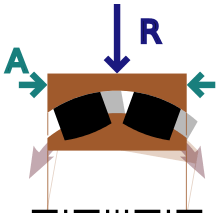Spherical roller bearing

A spherical roller bearing is a rolling-element bearing that permits rotation with low friction, and permits angular misalignment. Typically these bearings support a rotating shaft in the [bore] of the inner ring that may be misaligned in respect to the outer ring. The misalignment is possible due to the spherical internal shape of the outer ring and spherical rollers.[1]Despite what their name may imply, spherical roller bearings are not truly spherical in shape. The rolling elements of spherical roller bearings are mainly cylindrical in shape, but have a profile that makes them appear like cylinders that have been slightly over-inflated.[2]
Construction
Spherical roller bearings consist of an inner ring with two raceways inclined at an angle to the bearing axis, an outer ring with a common spherical raceway, spherical rollers, cages and, in certain designs, also internal guide rings or center rings. The bearings can also be sealed.
History
The spherical roller bearing was invented by engineer Arvid Palmgren[3] and was introduced on the market 1919 by SKF.[4] The design of the bearing that Arvid Palmgren invented is similar to the design that is still in use in modern machines.
Designs


Most spherical roller bearings are designed with two rows of rollers, allowing them to take very heavy radial loads and heavy axial loads. There are also designs with one row of rollers, suitable for lower radial loads and virtually no axial load. These are also called "barrel roller bearings" or "Tonnenlager" and are typically available in the 202- and 203-series.[5]
The internal design of the bearing is not standardised by ISO, so it varies between different manufacturers and different series. Some features that may or may not exist in different bearings are:
- Lubrication features in inner or outer ring
- Central flange
- Guide ring or center ring
- Integrated seals
- Cage
Dimensions
External dimensions of spherical roller bearings are standardised by ISO in the standard ISO 15:1998. [6] Some of the common series of spherical roller bearings are:[7]
- 213
- 222
- 223
- 230
- 231
- 232
- 238
- 239
- 240
- 241
- 248
- 249
Materials
Bearing rings and rolling elements can be made of a number of different materials, but the most common is "chrome steel", (High carbon chromium) a material with approximately 1.5% chrome content. Such "chrome steel" has been standardized by a number of authorities, and there are therefore a number of similar materials, such as: AISI 52100 (USA), 100CR6 (Germany), SUJ2 (Japan) and GCR15 (China).[8]
Some common materials for bearing cages:[9]
- Sheet steel (stamped or laser-cut)
- Polyamide (injection molded)
- Brass (stamped or machined)
- Steel (machined)
The choice of material is mainly done by the manufacturing volume and method. For large-volume bearings, cages are often of stamped sheet-metal or injection molded polyamide, whereas low volume manufacturers or low volume series often have cages of machined brass or machined steel. For some specific application, special material for coating (e.g. PTFE coated cylindrical bore for vibratory application) is adopted.
Manufacturers
Some manufacturers of spherical roller bearings are SKF, Schaeffler, Timken Company, NSK Ltd., NTN Corporation and JTEKT.
Since SKF introduced the spherical roller bearing in 1919, spherical roller bearing manufacturers have purposefully been refined through the decades to improve carrying capacity and to reduce operational fricition. This has been possible by playing with a palette of parameters such as materials, internal geometry, tolerance and lubricant. Nowadays, spherical roller bearing manufacturers are striving to refine the bearing knowledge towards more environmentally-friendly and energy-efficient solution.
Applications
Spherical bearings are used in countless industrial applications, where there are heavy loads, moderate speeds and possibly misalignment. Some common application areas are:[4][10]
- Gearboxes
- Wind turbines
- Continuous casting machines
- Material handling
- Pumps
- Mechanical fans and blowers
- Mining and construction equipment
- Pulp and paper processing equipment
- Marine propulsion and offshore drilling
- Off highway vehicle
See also
- Bearing (mechanical)
- Rolling-element bearing
- Self-aligning ball bearing
- Spherical plain bearing
- Spherical roller thrust bearing
- Tapered roller bearing
References
- ↑ "Misalignment". SKF. Retrieved 5 December 2013.
- ↑ http://www.bearingtips.com/spherical-roller-bearings/What do you know about Spherical Roller Bearings? Bearing Tips: A Design World Resource
- ↑ Palmgren, Arvid. "Patent application Spherical roller bearing" (PDF). SE5206CI. Retrieved 5 December 2013.
- 1 2 "Why spherical roller bearings?" (PDF). 6547/2 EN. SKF. Retrieved 5 December 2013.
- ↑ "Tonnenlager". Schaeffler Gruppe. Retrieved 5 December 2013.
- ↑ "Dimensions". SKF. Retrieved 5 December 2013.
- ↑ "Spherical roller bearing series". AST Bearings. Retrieved 5 December 2013.
- ↑ "Bearing materials". AST Bearings. Retrieved 5 December 2013.
- ↑ "Cage materials". SKF. Retrieved 5 December 2013.
- ↑ "Typical spherical roller bearing applications" (PDF). Timken. Retrieved 5 December 2013.
| Wikimedia Commons has media related to spherical roller bearing. |